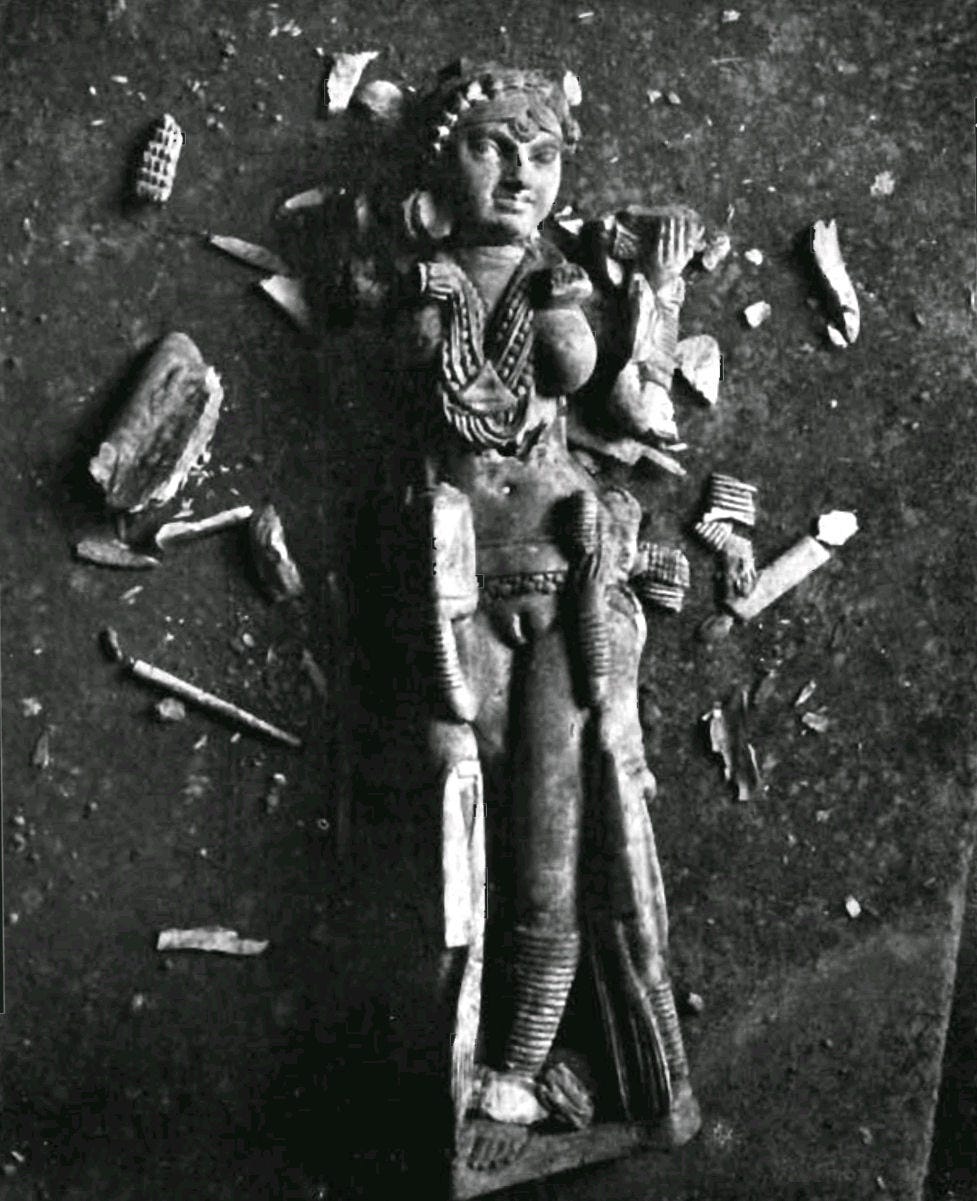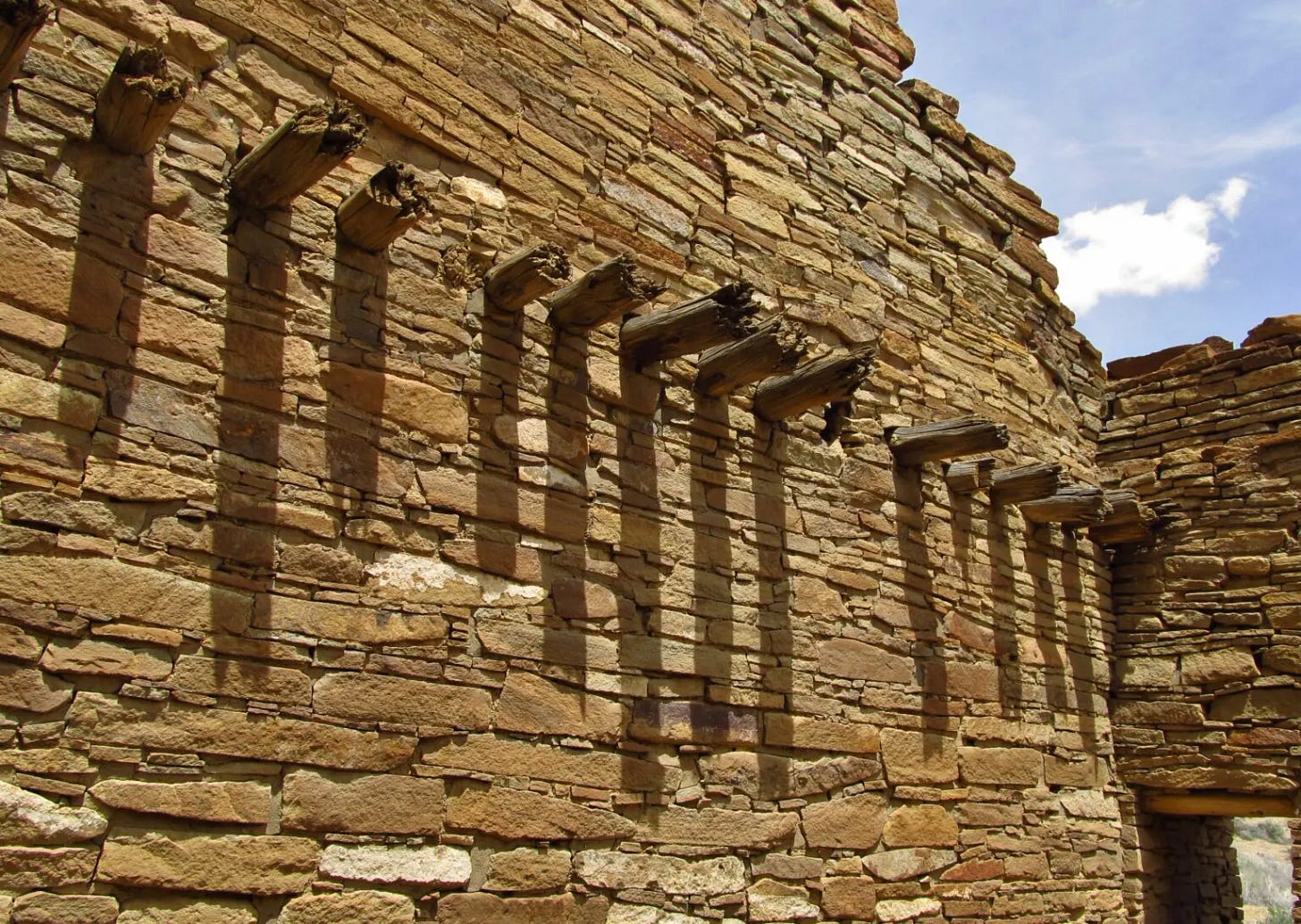Pasts Imperfect (4.20.23)
Uncovering Cleopatra, Connecting Rome & India, Chaco Canyon Timber, and More

This week, Shelley P. Haley discusses her role in the new Netflix docuseries Queen Cleopatra. Then, new books chart the interaction between Rome and India, dendrochronological analyses reveal how Ancestral Pueblans harvested timber in Chaco Canyon, the scholarship behind the “ecological turn” within the study of the ancient Greek Mediterranean, 3-D scanning looted objects in modern museums, new ancient world journals, and more.
Uncovering Queen Cleopatra by Shelley P. Haley
Cleopatra (69-30 BCE) has haunted me as a historical figure since I was in junior high school. When I was learning about ancient European societies, my “world” history teacher informed us that we would not be learning about Africa or Asia because those places “contributed nothing to human history.” Those words have remained seared in my brain throughout my academic career.
I (terribly shy though I was) spoke up against the inaccuracy of the statement and was sent to the principal for talking back. But I never thought to question Cleopatra’s racial background. It was a habit of mine to “teach” my grandmother everything I was learning in school. She had to leave school before high school to support her family and so gave up her dream of being a teacher. I remember very clearly the day we learned about Cleopatra. I went home and reported the lesson to my grandmother. She shook her head and gently took my chin in her hand and said, “remember, Shemdem (her nickname for me), no matter what they tell you in school, Cleopatra was Black.”[1]
Cleopatra didn’t nudge me again until I was teaching a course on women in the ancient world at Howard University. I gave the conventional spiel about Cleopatra being “Greek”. When some students gently challenged me, I studied her genealogy and realized there were so many question marks about various mothers of the Ptolemaic pharaohs. Very few classicists dared speak the unspeakable, so I jumped into the breech.
Big jump forward: I was contacted by the recruiters for a Netflix series on African Queens in July 2021. They asked me to be a consultant for the second season, focused on Cleopatra. I didn’t want to at first and did my best to scare them off with my passionate Black feminist response! It turns out that was exactly what they were looking for. Then I learned that Jada Pinkett Smith would be an executive producer. After that, I met the other producers (all based in Britain) with whom I would be working most closely. They were ALL WOMEN OF AFRICAN DESCENT OR WOMEN OF COLOR! The researchers were excellent and very thorough. The writers were also women of color. As our relationship progressed, I became quite close to the other Black women.
There were moments when we felt the writers (who had no classical training) were getting sucked into the misogyny—and I would say misogynoir—of Plutarch and Shakespeare. The complaints of my fellow Black women seem to fall on deaf ears with their white associates. I had to step in and even threaten to leave the production. Things changed dramatically and I became a shadow producer: I approved the casting decisions and insisted that the enslaved people not be exclusively Black people. I also weighed in on the costume design, encouraging the designers to make the clothing culturally appropriate for each ethnic group: Egyptians, Romans, etc. I am very proud of the result and hope viewers will approach the series with an open mind.
There are a lot of misconceptions surrounding Cleopatra. For a docudrama like Queen Cleopatra, popular media take their cues from scholars. As long as scholars don’t apply the same critical thinking they demand from their students, lies, mistruths, and disinformation about Cleopatra—indeed all women of African descent—will persist in academia and in popular culture. I wish we could put an end to the wretched misunderstanding of sibling marriages among the pharaoh class of ancient Egypt. I am not sure how successful this docudrama is in this regard. I love that one of the first scenes (spoiler alert) focuses on Cleopatra as a scholar.
I have also noticed a begrudging acceptance that as an Egyptian, Cleopatra was a woman of African descent. But with that also comes another disturbing trend: the notion that she was ugly! I blame willful misinterpretation of Plutarch, who hedges his bets about her beauty. Granted, Plutarch’s Greek prose is nearly impenetrable in his initial description of Cleopatra. He says, “For indeed her own beauty, as they say, was not, in and of itself, completely incomparable, nor was it the sort that would amaze those who saw her…”. (Life of Antony 27.2) But let’s be clear: Plutarch NEVER laid eyes on Cleopatra; he admits he is relying totally on hearsay. Concluding from this description that Cleopatra was ugly is utter nonsense.
The question remains: can a Netflix show modify modern perceptions of this important African queen? An adage attributed to Samuel Butler (1612-1680) and quoted by Mary Wollstonecraft (1759-1797) in her A Vindication of the Rights of Women states: “Convince a man against his will; he is of the same opinion still.” This series will do nothing to change the minds of people who have internalized racism and white supremacy. My hope is that most people will see that this series is a realistic portrayal of Cleopatra. It may also be the first step in helping people avoid the trap of applying OUR construct of race to ancient societies. I am proud and pleased that the producers cast a woman of African descent as Cleopatra. And guess what?! The sky hasn’t fallen!
New readers delving into my research surrounding Cleopatra should realize that she is usually tangential to my larger aim of reclaiming the rightful place of Black women in ancient historical discourses. Many young Black women scholars have found these articles helpful:
Shelley P. Haley, “Black Feminist Thought and Classics: Re-membering, Re- claiming, Re-empowering” in Nancy S. Rabinowitz and Amy Richlin (eds.), Feminist Theory and Classics, New York: Routledge, 1993: 23-43.
_____“Be Not Afraid of the Dark: Critical Race Theory and Classical Studies” in Laura Nasrallah and Elisabeth Schüssler Fiorenza (eds.), Prejudice and Christian Beginnings: Investigating Race, Gender and Ethnicity in Early Christian Studies, Minneapolis, MN: Fortress Press, 2009: 27-50.
Cleopatra also figures in these articles:
Shelley P. Haley, “Livy's Sophoniba,” Classica et Mediaevalia 40 (1989): 171-81.
_____“Race and Gender” in Denise Eileen McCoskey (ed.), Cultural History of Race in Antiquity, London: Bloomsbury Academic, 2021: 119-136.
Other works I have found useful:
Sally-Ann Ashton (2008). Cleopatra and Egypt. Blackwell.
Francesca T. Royster (2003). Becoming Cleopatra: The Shifting Image of an Icon. Palgrave McMillan.
Scott Trafton (2004). Egypt Land: Race and Nineteenth Century American Egyptomania, especially chapter four, “Undressing Cleopatra: Race, Sex, and Bodily Interiority in Nineteenth-Century American Egyptomania.” Duke University Press.
[1] She actually said “colored”, the terminology of the time. I have updated it.
Netflix will premiere Queen Cleopatra on May 10, 2023.
Public Scholarship and a Global Antiquity
At The New York Review, William Dalrymple reviews three new books addressing the interactions between Rome and India: The Indian Ocean Trade in Antiquity: Political, Cultural and Economic Impact, edited by Matthew Adam Cobb; Globalization and Transculturality from Antiquity to the Pre-Modern World, edited by Serena Autiero and Matthew Adam Cobb; and Rome and the Indian Ocean Trade from Augustus to the Early Third Century CE by Matthew Adam Cobb. The monographs look at material culture and provide economic analyses that span from Berenike to Malabar. Dalrymple notes, “Together, the books represent a thorough rethinking that dramatically changes our understanding of the Indian Ocean trade in antiquity.” As they show, the implications of trade between these two cultures are vast, significant, and worthy of study.

At Sapiens.org, Steve Nash, Senior Curator of Archaeology at the Denver Museum of Nature and Science, details the “The Astounding Origins of Chaco Canyon Timber.” Isotopic and dendrochronological analyses have revealed that the Ancestral Pueblans harvested trees for their “Great Houses” from a 7,500 square mile area. As Nash notes, “These biochemical results accord with Indigenous Oral Traditions from numerous societies and archaeological evidence for how Native peoples used natural resources before Europeans colonized their lands.”

In the latest issue of the Journal of Hellenic Studies, Ruben Post provides a synoptic review of recent books on “Environment, sustainability, and Hellenic studies” and suggests areas for further research. What does the “ecological turn” within the study of Greek antiquity mean? Post gives readers “overviews of scholarship addressing sustainability and the conservation of natural resources; ecology and religion; and societal resilience in the face of ecological stress.” What becomes apparent in this bibliographic journey is that the path forward continues to be through an interdisciplinary approach; one that challenges the traditional boundaries of the field.
In The New Yorker, Chantel Tattoli discusses the collective known as “Looty, whose mission [is] to ‘reloot’ heritage items.” Last year, members snuck into the British Museum to take secret 3-D scans that they then make into N.F.T.s available within the metaverse. Looty then gives 20% of their proceeds to emerging African artists “as grants, and keeps the rest to cover costs.” The other day, they invited Egyptologist Monica Hanna along as they guerrilla scanned the Rosetta Stone. What next? Well, a digital repatriation of sorts.
In Rashid, a port city near Alexandria which Westerners call Rosetta, they would use location-based augmented reality to put the stone near its original resting place; passersby could view it on their phones, as if it were a very old Pokémon. “And it’s there,” Nwaubani said. “But you can only access this in a digital form.”

As reported in The Guardian and first published in the journal Antiquity, there is a late antique “Lavish ancient Roman winery found at ruins of Villa of the Quintilii near Rome.” Emlyn Dodd, Giuliana Galli, and Riccardo Frontoni discuss the likely third century winery at the Villa of the Quintilii. Stamps point to it likely belonging to Gordian III (238-244 CE). There were dining rooms built in with a particular spectacle: wine must fountains. And in other late Roman viticulture news, a new study in PNAS reports that “Ancient DNA from a lost Negev Highlands desert grape reveals a Late Antiquity wine lineage.” As Pnina Cohen and her co-authors note, this lost vintage “may present an alternative to the classic winemaking grape cultivars. Our study of a legacy grapevine variety from the Negev Highlands desert of southern Israel sheds light on its genetics, biological properties, and lasting impact.” We’ll raise a glass to that! 🍷

New Antiquity Journal Issues (by @YaleClassicsLib)
Gerión Vol. 41 No. 1 (2023) #openaccess
Journal of Classics Teaching Vol. 24, No. 47 (2023) #openaccess
Cahiers de civilisation médiévale Vol. 65, No. 3 (2022) NB Tomasz Pełech, “Un réemploi de Flavius Josèphe par Foucher de Chartres : l’or arraché aux cadavres”
Gesta Vol. 62, No. 1 (2023) Roland Betancourt, “Between Wonder and Omen: Conjoined Twins and the Mandylion from Constantinople to Norman Sicily”
Oxford Journal of Archaeology Vol. 42, No. 2 (2023)
Early Christianity (EC) Vol. 14, No.1 (2023)
Antiquity Vol. 97, No. 392 (2023)
Arethusa Vol. 55, No. 3 (2022) The Reception of Greek Tragedy
Classical Journal Vol. 118, No. 4 (2023)
Yearbook of Ancient Greek Epic Vol. 6 (2022)
European Journal of Archaeology Vol. 26, No. 2 (2023)
Acta Antiqua Academiae Scientiarum Hungaricae Vol. 61, No. 4 (2021)
Cuadernos de Filología Clásica. Estudios griegos e indoeuropeos Vol. 33 (2023) #openaccess
Digital Scholarship in the Humanities Vol. 38, No. 1 (2023)
The Journal of Hellenic Studies Vol. 142 (2022)
Latomus Vol. 81, No. 4 (2022)
Ancient Society Vol. 52 (2022) NB Hedvig von Ehrenheim, “The Function of Serving a Ritualized Dinner to Slaves at Ancient Greek Festivals”
Vigiliae Christianae Vol. 77, No. 2 (2023)
Journal of the History of Ideas Vol. 84, No. 2 (2023) Christopher Stray “The Cambridge Greek Lexicon: An Essay-Review”
Vivarium Vol. 61, No. 1 (2023)
Otium Vol. 12 (2022) #openaccess
Public Lectures and Conferences
On Monday April 24, 2023 at 2pm, the SCIBS Research Center is hosting an online lecture by Cate Bonesho, titled "Carpe Diem: Saturnalia in Rabbinic Literature." As Bonesho notes, “The ancient Roman festival of Saturnalia is referred to by the Roman poet Catullus as the “best of days.” However, for many of the ancient Jewish communities, especially the classical rabbis living under Roman rule, the festival instead represented a productive time to demarcate the rabbinic constructions of Self and Other, as well as to authorize certain components of rabbinic Judaism.” Register for the lecture here.
On Wednesday, April 26, at 12:00 pm EDT, for Yale's Late Antiquity Reading Group (YLARG), monasticism expert David A. Michelson will discusses his recent monograph, The Library of Paradise: A History of Contemplative Reading in the Monasteries of the Church of the East. Follow the Zoom link to attend.
On April 27-28, 2023, the 2023 ACLS Annual Meeting Livestream Events commence.
Learn more about each event below, and sign up for the livestream links.
Thursday, April 27, 2023
4:00 PM EDT: Open Access Book Publishing: Why Now and What's Ahead
5:45 PM EDT: Joy Connolly in Conversation with NEH Chair Shelly Lowe
Friday, April 28, 2023
10:15 AM EDT: HBCUs: Legacy and Future
2:30 PM EDT: Joy Connolly's 2023 President's Report to the Council
6:00 PM EDT: Henry Louis, Gates, Jr. delivers the 2023 Charles Homer Haskins Prize Lecture







